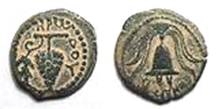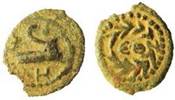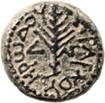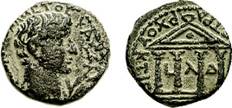Herod Antipas received purely Jewish but widely separated area - Galilee and Peraea (Jewish Transjordan). And the third son, Herod Philip, was given predominantly non-Jewish settlements in Syria. This was reflected in their coinage - no living things appear on the coins of Archelaus and Antipas, but Philip became the first Jewish ruler to place a portrait (of his benfactor, the Roman Emperor Augustus) on his coins.
The most common coins of Herod Archelaus (4 BCE - 6 CE) are small prutahs featuring a bunch of grapes and a crested helmet with his name and title spelled out in Greek (#30), and a ship's prow and wreath with his name and title abbreviated. (#31)

#30 - Grapes & helmet on coin of Herod Archelaus (H-1196)

A scarce double prutah of Herod Archelaus pictures a galley ship and conjoined double cornucopiae, inscribed in Greek with his name and title. (#32)

#32- Galley ship and double cornucopiae on double prutah of Herod Archelaus (H-1194)
Antipas plays a key role in the New Testament, adding to the desirability of his coins: "And King Herod (Antipas) heard of him (for his name was spread abroad) and he said, that John the Baptist was risen from the dead" (Mark 6:14). The rare coins of Herod Antipas (4 BCE - 39 CE) generally feature an upright palm branch surrounded by the Greek inscription "Herod the Tetrarch." The name of the city - Tiberias (named by Antipas after the Roman Emperor Tiberius) - where the coins were minted, is contained within a wreath on the reverse.


#33 - Palm branch and wreath on typical coin of Herod Antipas (H-1199)
The coins of Herod Philip II (4 BCE - 34 CE) are generally of middle bronze size, depicting a portrait of the Roman Emperor on the obverse and the facade of a tetrastyle (four columns) temple on the reverse; they are all dated according to the Emperor's regnal year. (#34)

#34- Emperor Tiberius and temple on coin of Herod Philip II, 30/31 CE (H-541)
An extremely rare coin (#34A) depicting the portrait of Herod Philip himself, when he was about 55 years old, was struck year in 30 CE in Caesarea Philippi. It appeared in an October 2015 auction of www.fontanillecoins.com with an estimate of $10,000-12,000.

34A- Herod Philip II, Caesarea Philippi, 30 CE
© 2020-Mel Wacks